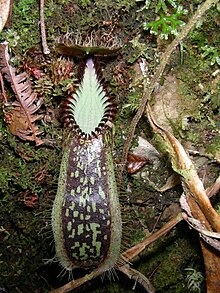Nepenthes hamata
| Nepenthes hamata | |
|---|---|
 |
|
| A lower pitcher of Nepenthes hamata from Mount Katopasa, Sulawesi | |
| Scientific classification | |
| Kingdom: | Plantae |
| (unranked): | Angiosperms |
| (unranked): | Eudicots |
| (unranked): | Core eudicots |
| Order: | Caryophyllales |
| Family: | Nepenthaceae |
| Genus: | Nepenthes |
| Species: | N. hamata |
| Binomial name | |
|
Nepenthes hamata J.R.Turnbull & A.T.Middleton (1984) |
|
| Synonyms | |
|
|
Nepenthes hamata /nᵻˈpɛnθiːz həˈmɑːtə/ is a tropical pitcher plant endemic to Sulawesi, where it grows at elevations of 1400–2500 m above sea level.
The specific epithet hamata is derived from the Latin word , meaning "hooked". It describes the appearance of the highly developed peristome teeth of this species.
Nepenthes hamata was first encountered by Western explorers many decades before its formal description and recognition by science. Dutch botanist Pierre Joseph Eyma collected herbarium material of this species as early as 1938; this would later be used to designate a type specimen.
In 1984, two formal descriptions of this species were published in close succession: Shigeo Kurata described it under the name N. dentata in The Gardens' Bulletin Singapore, while John R. Turnbull and Anne T. Middleton called it N. hamatus in the journal Reinwardtia.
As explained in the introduction to his describing paper on N. dentata, Kurata first became aware of the species more than a decade earlier, on a 1972 visit to Herbarium Bogoriense:
...
Wikipedia

